Inquiry Behavior In Buildings Magazine
The purpose of this white paper is to explore lead generation in BUILDINGS magazine. The paper will discuss advertising response behavior within that publication through various channels and, therefore, demonstrate the Internet’s impact on lead generation. Besides focusing on BUILDINGS, the report draws on Accountability Information Management, Inc.’s (AIM) studies of thousands of magazines over the years (we receive 1,000+ publications in our offices each month). The objective is to study how leads are generated, the impact of the Internet on that process, and then to help advertisers make better conclusions on their ROI using advertising.
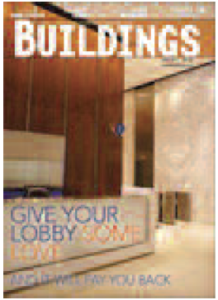
Background
BUILDINGS magazine serves Building Development Firms, as well as Building Management Firms, Manufacturing, Computer/High Tech and other building markets like Financial/Insurance, Retail/Chain, Hospitality and Education. Readers own and manage these properties, and many are also members of associations such as BOMA, APPE, IREM, IFMA and ASHE, among others.
The actual titles of these readers range from CEO/Owner/Partner to VP/Director of Facilities, Directors of Real Estate, Directors of Construction, and other facilities-related occupations and titles, like Construction Project managers, Staff Architects and Security/Safety Directors. The magazine’s BPA audit statement provides a very comprehensive overview of this readership of over 72,000 individuals.

Table 1 illustrates BUILDINGS’ qualified circulation, including audited numbers showing how many were added, removed, and how many are 1-year and 2-year qualified at the time this study was conducted. BUILDINGS’ readers are 100% “direct request,” which means people must ASK to receive it before they receive it. BPA is one of the official auditing companies that help advertisers understand their investment by verifying the magazine circulation.
For this research, Tony Dellamaria, the publisher, provided Accountability Information Management, Inc. (AIM) one year’s worth of inquiries from the following channels:
- eResponse (generated from monthly eblasts)
- Fax (generated from faxed in print cards)
- Internet (generated from Online Web Inquiry Card)
- Mail (generated from mailed in print cards)
What is not known is how many leads came to advertisers directly from the advertising (that is, went to the website of the advertiser or the microsite created by the advertiser to track response, the FAX number, etc.). But then, this is not known from any magazine and its advertisers, as advertisers do not typically share this information. And while it can be speculated based on AIM’s experience with clients in these efforts, all consideration of this response channel is outside the scope of the whitepaper.
In addition to the study of this file, AIM conducted over 50 random interviews on this file to provide additional qualitative understandings of lead behavior. The number of interviews needed to be assured of some certainty when qualitative of research is done is N=30. Peter DePaulo, in the December, 2000 Quirk’s Marketing Research Review wrote How large should the sample size be in a qualitative study? stating:
“Until the definitive answer is provided, perhaps an N of 30 respondents is a reasonable starting point for deciding the qualitative sample size that can reveal the full range (or nearly the full range) of potentially important customer perceptions. An N of 30 reduces the probability of missing a perception with a 10 percent-incidence to less than 5 percent (assuming random sampling), and it is the upper end of the range found by Griffin and Hauser. If the budget is limited, we might reduce the N below 30, but the client must understand the increased risks of missing perceptions that may be worth knowing. If the stakes and budget are high enough, we might go with a larger sample in order to ensure that smaller (or harder to reach) subgroups are still likely to be represented.”
Professor George Gaskell in Qualitative Researching wrote Individual and Group Interviewing and discussed the number “30” extensively. He noted that the range of error attached to a 50/50 split of a randomly selected sample of 30 on any indicator would be plus or minus 20%. Hence, if half of the 30 people interviewed said they would do this thing, and the other half said they wouldn’t do the thing, it could safely and confidently be said that in the population of manufacturers interviewed, 30 to 70% of them would do it.
People today want 100% of everything – but that’s not the point, and it never was. In an effort to minimize risk, we lose sight of the need to move forward and, perhaps, fail. This white paper was conducted to help avoid failure – failure in making assessments that may not be grounded on research. But, it is not the end-all. No piece of research really is (there is ALWAYS risk). Research – good qualitative research – simply seeks to provide some guidelines for “the next step.”
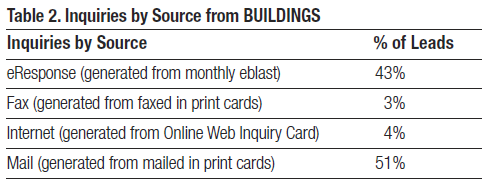
Table 2 demonstrates the source of leads via the channel they came through. Note that prior to a tactic like eResponse or the advent of the Internet, all the inquiries would have come through the “mail.” In both cases (now and then), a reader could have still called an advertiser, but the publisher would never know that (see earlier discussion).
AIM studies have documented the shift: as channels like eResponse are created, mail inquiries drop, but people’s level of interest stays the same and MOVES to a different channel. In fact, in all of AIM’s work, it’s been shown that advertising inquiries in magazines generally come from between 6% and 20% of a magazine’s circulation via the reader service card, depending on the audience. In other words, 80% or more of a magazine’s circulation is using other-than-reader-service channel to inquire on an ad, if they inquire at all. Moreover, the “number” of leads has, relatively speaking, remained the same; only the channel has changed.
Furthermore, AIM’s interviews asked a very important question that may shed some light on how people seek information: How do you most prefer to get product information and stay up to date?
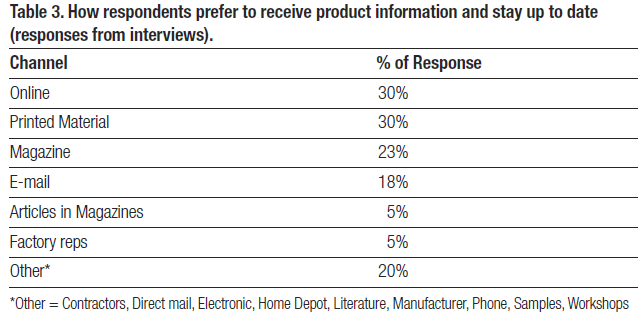
*Other = Contractors, Direct mail, Electronic, Home Depot, Literature, Manufacturer, Phone, Samples, Workshops
Table 3 shows the results. If the response from “Magazine” and “Articles in Magazines” are added, you can still see that “print magazines” are still a powerful force in how these people get their information. While no one denies the growth of the Internet and its social media channels, BUILDINGS readers use the magazine for receiving product information.
How people receive and seek information is important to remember throughout this discussion. For example, one magazine AIM studied reached users of mainframe computers and generated (on average) 3 leads per ad. At a national sales meeting for that publication, when AIM showed the sales force that number, there was an outcry from the staff. “I can’t take that into the client,” was the unanimous exclamation. “It’s too low.” Of course, it wasn’t too low. Number of inquiries are what they are for many reasons, and AIM’s experience has shown that ANY number, once understood, is valid. The perception was that “3” was “too low.” AIM asked: What was the average order on a per lead basis for the mainframes covered by the publication? The answer was: over $1.5 million. The room became silent, and the point made. Each individual lead had the potential to generate a $1.5 million sale. So, how many “ones” do you really need?
In a more recent example, a publication dropped the reader service card, and when confronted with that, the publication said that according to their studies, only 4% of their readers used that channel. “Well, that’s 4% more than we are getting now,” AIM replied, and put the magazine on notice and the schedule in jeopardy.
This “potential” idea of what is or is not available is extremely important in understanding inquiry numbers. Here is why. One of the questions asked was: If the person recalled if they purchased any of the products they inquired on from BUILDINGS? The results showed that 48% said “Yes” they did purchase the product, while 52% said they did not. Appendix 1 contains the “Yes” and “No” responses. A study of them will prove revealing with this undeniable truth: advertising leads to sales.
Another question was: How important is it for companies to advertise their products/services in BUILDINGS? Again, 53% said that it was “very important,” and another 34% said “extremely important.” While 13% said “somewhat important,” none of the people advertised thought that advertising was unimportant! A Facility Director for a 105 assisted-living apartments and 42 Alzheimer beds told us: “Advertising in major trade publications gives manufacturers and service providers more credibility.” Did he purchase the product he inquired on? No. But, “I do my product research on things I see advertised and then recommend to the CEO/Owner products for capital improvements. At certain levels, I buy what is needed.” How do you “document” the influence of that kind of inquiry?
Indeed, one of the inquiries called did not “officially” receive BUILDINGS magazine. We asked how he got it, and he told us, “My boss threw the magazine on my desk with a post-it note on one of the ads and said, ‘buy that,’ so I did.”
The point is, the “potential” for any inquiry has to be explored BEYOND the initial inquiry – cultivated, nurtured, and finally, closed – regardless of HOW it shows up. This is the sales cycle – a cycle which people often forget is part of the process in this age of instantaneous response! Appendix 2 contains all of the verbatim responses to this question on the importance of advertising in BUILDINGS.
Ad Sizes
The next Table shows the inquiries and the number of insertions by ad sizes for the reader service card only, which is always an interesting observation. There is almost a one-to-one ratio between the number of inserts to inquiries. The table demonstrates this for BUILDINGS, but has been reflected in virtually every magazine AIM has studied in the past. In other words, for every ad in any size that ran, almost the same percentage of corresponding inquiries was produced (i.e., of the 22% of insertions of ½-page, four-color ads, 23% of the inquiries were associated with those ads, etc.)
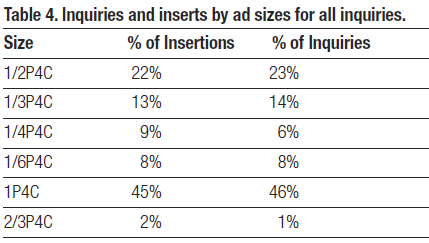
This is good news for advertisers – and publishers. It means that regardless of size, an advertiser can expect leads. The difference of course will be in the quantity per advertiser (discussed later in this report), and quality. But one of the real benefits of advertising is the non-inquiry. In other words, not everyone who sees and reads the ad goes on to inquire.
There are basically three behaviors that a reader can take when an ad appears in a magazine (and while this is true of any ad on the Internet, television, etc. for that matter, but the focus here are the ads in BUILDINGS). These three behaviors always happen in the same order, though that order can break and collapse at any moment, preventing the next behavior from taking place.
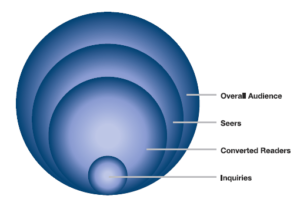
The three behaviors are: seeing, reading and acting (which includes ignoring, which is a behavior in itself). The first “break” in the cycle happens when the reader does not even see the ad, and therefore, will flip the page or move toward another part of the page (or in the case of an e-mail blast, not open the e-mail, or if opened, pass over the advertiser’s message). If the reader sees the ad, he might not read the ad. If he sees and then reads the ad, he might not act upon the ad, but rather, ignore it (or file it away in his or her mind for later). But if he sees and reads it and acts on it, it is considered an inquiry. While it is true the inquiry can be the result of just seeing the ad, AIM’s qualification experience suggests strongly that reading follows seeing. People simply don’t have the time to “just look” and then ask for information. They have to READ about the product or service being offered, gain some “connection” to the product or service, and then take the action. Unlike a consumer magazine, which often uses advertising to build brand recognition and preference, business-to-business advertising is comprised of benefit statements used to connect with readers and generate interest.
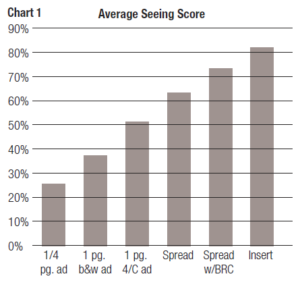
Chart 1 shows the overall percentages of “seeing” scores – people who report seeing an ad – based on sizes of ad. Note that clearly, the differentiation is the size of the ad. The more seers you want, the larger size ad you should run. The number of seers, therefore, helps you understand inquiries further. That is, without seeing the ad, you’d never inquire. By default, the higher number of seers, the more “potential” your ad will have to produce inquires.
Table 5 shows the potential “seers” based on the size of ads in BUILDINGS magazine. It shows the number of potential people the ad will initially draw. This would be followed by a certain percentage who would read it and then another percentage of that group who would go on to inquire.
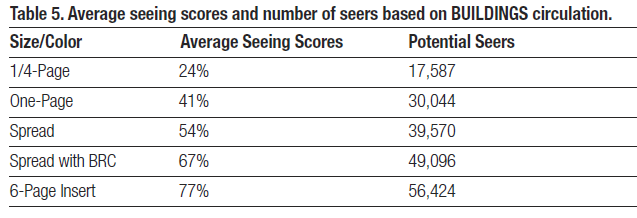
One of the questions asked in the interviews was if people read “all” the ads in the magazine? The response was 68% of the people interviewed said “No” to this question, but 32% said “Yes.” But, their responses tell a different story. For example, while they may not “read” every ad, they look at everything in the magazine, including all the ads. “Because I am never sure what I will find and since I don’t use the internet as much as other people, this is where I get my information,” a Work Leader at the Department Of Defense told us. “Cover to cover, because I don’t want to overlook something I might need for a project I’m working on,” said an individual doing specification work. Another individual who manages facilities at a university said he follows a process: “I do a brief review, and if something jumps out at me, I put it to the side. Then look more in-depth a second time, and then a third to what pertains to my project.” In fact, one owner said, “I pick BUILDINGS up first thing in the morning, have a cup of coffee and am done with it in about half an hour. It’s a good educational tool.” One owner admitted, “I sometimes read ads more than some of the articles.”
Categories
In the research, one of the questions asked was: Are there any product groups or services you are not seeing advertised in BUILDINGS that you would like to see? Of those interviewed, 79% said “No” to this question. Of the 21% that said “Yes,” some of their comments went along these lines. For example, there was the philosopher: “It’s always difficult to know what you don’t know;” or the advocate of BUILDINGS: “Buildings magazine does a pretty good job. The magazine is one source to get a perspective.”
Here is a sampling of others:
- “Information on system side engineered building e. BIM, Energy information systems as offered by various suppliers would be a good thing to have in magazine.”
- “More on solar ”
- “Don’t think they do a lot with security Also, I would like to see articles on parking lot maintenance.”
- “Custodial supply stuff; you have to hunt for the products & often can’t find it in your area, but the magazine has ads that direct ”
More than one said, “The whole building. If I see something new, I will give it to someone else. We have architects on staff, and they need to know this.”
From an advertising point of view, ads in BUILDINGS magazine fell into 25 different categories, as shown in Table 6. The top categories with 9% each of the thousands of inquires produced were: Roofing, Flooring, HVAC, Contract/Maintenance/Services Equipment and Plumbing/Washrooms.
Surprisingly, Walls and Pest Control have less than 1% each.
Does that mean that the readers were not interested – or that advertisers have not yet found the “opportunity” to satisfy a need?
Table 6. Categories and the percentage of ads within those categories from advertising in BUILDINGS.
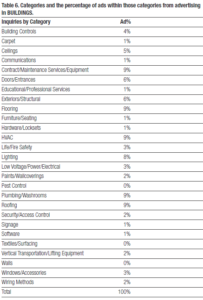
Table 7 extends these results by looking at the categories from not only the ad point of view, but from all inquiries (PR included). Thus, you can see that Contract/Maintenance/Services Equipment, which had a lot of the ads, also pulled a lot for its category and was a fairly competitive category with 9% of the advertisers in it. The category also controlled 10% of the insertions. Compare that to Flooring, however, which was not as competitive, but held the stronger interest. This is actually an opportunity for the flooring manufacturers, because what this means is that these readers have a strong interest in the category, and there are not a lot of people offering up information in that category.
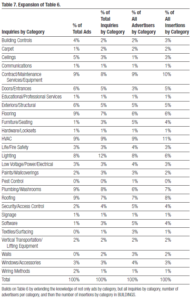
Builds on Table 6 by extending the knowledge of not only ads by category, but all inquiries by category, number of advertisers per category, and then the number of insertions by category in BUILDINGS.
The Readership Chain
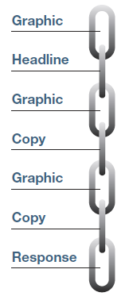
Reading habits are different today from years ago. In fact, reading habits change continually, especially with social media. For example, more magazines and newspapers were published in the 1960s than in the years prior. This is when eye-movement and reading studies were conducted (the first studies using eye movements to study the processing of ads appeared in the 1960s conducted by the famous Daniel Starch). They found then that reading was more rapid, and skimming occurred more often than in the past. Today, with the Internet, texting and television, skimming has been accelerated, making it even more difficult for an ad to secure and lock in attention, much less be read. Imagine what Dr. Starch would say about Twitter!
Perhaps more important, the “need for speed” has diminished the importance of reading for comprehension. Comprehension definitely diminishes as skimming increases. An analogy is listening to Mozart at 3x, or any song 3x or 4x the intended speed. Comprehensive and appreciation diminish accordingly. Thorough understanding cannot take place unless attentive reading takes place, and this means that a proper amount of attention must be paid to the subject matter – regardless whether it’s 140 characters or more.
But, that is the world in which advertising operates today. The number of advertisers and ways to advertise has greatly increased. Consequently, it is more difficult to attract attention to enable reading (and therefore comprehension) to take place.
The Readership Chain (left) shows the de-linking potential taking place in today’s fast-paced reading climate. The chain itself is expandable. That is, the relationship between graphic and copy can be multiplied (except with Twitter, though placing in a reference within your Tweet that takes you to a website can be considered a “graphic”).
In a print advertisement, the importance of the graphic and copy relationship cannot be underestimated. The reader is attracted by the graphics, reads the headline, goes back to the graphic, starts the copy, checks the graphic, reads the copy and then finally responds. If any of those “links” are broken, nothing happens: The reader turns the page.
So, why do people read ads? Do they read ads? There are numerous studies that put forth reasons and answers to these questions. The fact is that people read to do one of two things: 1) gain something, or 2) protect what they have. Bob Stone, one of the fathers of direct response, said this about reasons why people buy things, and it is also true of why people read things. Reading advertising is not really different. Therefore, what must exist first is the inherent interest in the topic being presented.
The fact that this interest cannot be measured per se is one of the reasons for “qualified” circulation. Publishers gather similar people with similar interests around a topic and publish a magazine geared to those people. But, it is important to understand that the act of reading is NOT related specifically to the size of the ad. On a ratio basis, a smaller ad can have a higher readership than a larger ad.
Traditional readership studies neglect that ratio, the implication being a larger ad has higher readership. This is simply not true.
The next series of tables demonstrate readership, as they profile the inquirers studied against the overall circulation of BUILDINGS. Note, for example, that overall, Table 8 shows the inquirer profile matches the overall circulation profile fairly consistently, indicating that geographically, this is an excellent sampling of people from the magazine’s circulation who came forward and “raised their hand.” Indeed, with just a few exceptions, inquirers match the circulation in terms of location.
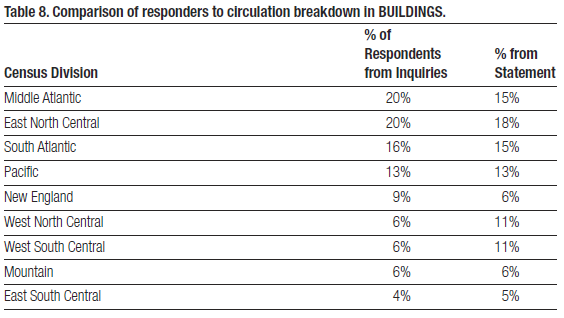
Table 9 demonstrates a similar pattern, as it shows the primary business of the organization who responded, and from the statement of circulation. Indeed, inquirer percentages are higher in the key categories that the magazine prides itself in reaching: building development firms, and management firms!
Table 9. Comparison of responders to circulation breakdown for primary business of people in BUILDINGS.
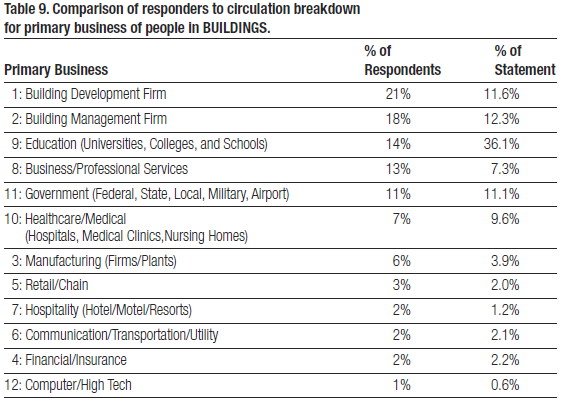
Finally, an action takes place. A magazine is accountable for helping deliver the action (in the form of the inquiry) to the advertiser. The ad is responsible for providing vehicles to respond, such as websites or phone or fax numbers. Only some of the people who read ads act upon them. This is why a readership number (provided by research companies or our own AIM ratio) is important. The number can provide insight into people who have read the message, but who may not have an immediate need and hence do not immediately respond.
People have debated “exposure” versus “response” for years, and some settle for exposure. However, response is the goal of advertising; nothing happens until you sell something. The underlying goal of advertising, then, is to penetrate the minds of targets with exposure. When the need does arise, if it isn’t present when the ad is read, the target will “remember” the company and take the appropriate action (purchase) when the need does arise. Therefore, knowing the readability of the ad is important, and the AIM ratio provides that measurement.
How people take action is important to understand. For example, while many companies provide toll-free phone numbers, not all companies provide 26 different phone numbers to measure the advertising in 26 different trade publications, which is what AIM did for a client. These “direct mail” type tactics are important to not only understand response, but to shape better response by enabling people to respond the way they want to respond.
Historically, the Reader Service Card delivered trade publication inquiries to advertisers. With the use of the Internet, however, that is changing. As pointed out earlier, the use of the Reader Service Card is diminishing; readers may find it more convenient to go directly to the advertiser’s website or to call the advertiser. But, that is not always the case, as evident by this study in BUILDINGS magazine. Inquiries from the Reader Service card remain one measure of this inquiry puzzle, and frankly, hold clues to understanding response and inquiries. To truly measure response, all forms of feedback must be accounted for. This brings the focus of the discussion to why people respond and inquire to ads at all.
Why People Respond. In essence, people respond because they have a need. Like Pavlov’s dog, a bell rings, and they are urged into action. Response to stimulus is an ongoing problem to advertisers, which is why the advertising world is under siege. Frankly, there are too many different bells that can ring. Given the customizable options in play today, advertisers can change the tones of those bells at will, and the customers and prospects may never know it even happened. Together, these present the advertiser with a huge dilemma: Which bell do you ring, and when do you ring it?
Some clues can be found in the research published on these topics. Many of these are academic studies, however, that do not account for real-world observation – or action. Figuring out why people respond includes understanding their “hot buttons” and the timing of the offer more than “how” the sale is presented. But, to generate any kind of response, the advertisement has to be seen and read; otherwise, nothing happens. Therefore, understanding why people respond requires an examination of what gets ads seen and read (as previously discussed), as well as the follow-up to the response! In other words, a study of inquiries and why they respond would be the best way to measure response (which so happens to be the subject of this white paper).
Impact of the Internet. The Internet – or now of equally important social media – has dramatically re-shaped lead generation
- not the quantity, but “how” inquiries are made and followed up In this age of “engagement,” advertising itself has become frowned upon and banned in the social media circles. Indeed, get caught advertising, and you could lose your followers!
Yet this too is changing, as Facebook and Twitter move to understanding advertising and its revenue power. Social and Mobile are helping Digital challenge traditional advertising, according to STRATA’s third quarter survey. In fact, 89% of respondents indicated that they would use Facebook in their campaigns (up 10% from last quarter). STRATA (owned by Comcast Cable) is the only system provider that connects both media buyers and sellers.
On average, over $50 Billion in advertising dollars flow through STRATA systems per year, making it a reliable resource for this type of information.
These platforms disrupt traditional channels, and change the way the game is going to be played. For example, many publishers explain to advertisers that lead generation has fallen off since the advent of the Internet. Advertisers, on the other hand, complain about the same thing: that leads have fallen off. This is why many publishers underwrite the dropping off by providing advertisers what is called “bonus” leads. But have leads really dropped off? Or, has the “channel” of the inquirer changed? Consider the following:

The data presents a comparison of the many thousands of leads generated over a period of two years from a different publication, but is typical when AIM does such studies. While direct leads (to advertisements run by advertisers) fell 11%, the bonus leads (leads collected and given by the publisher to advertisers in specific, related areas) rose 21%. The net effect of this is a 10% gain to advertisers! Moreover, 2008 actually produced 1% more leads overall than 2007. So why do advertisers complain about leads falling off when they are obviously not?
One company AIM studied several years ago (when bonus leads started taking shape) had more successful equipment placements on the bonus leads than on the leads that were directed at their advertisements! This demonstrates that regardless of WHERE the lead comes from, it is the follow-up that is the more critical factor to turning that lead into a customer. We believe advertisers say leads fall off because of inadequate follow-up.
In a separate study, AIM conducted a comprehensive follow-up study on Reader Service Cards in one magazine. AIM circled EVERY number using separate cards (to avoid the publisher throwing out our cards as a hoax). Here are the results of that study for your consideration:
- 30% of the advertisers responded to the request for information. That means 70% paid no attention to the request!
- The average response time for the 30% who responded to the request was 37 days.
- The average creative costs for the print material received is estimated (at $1,500 per page, conservatively) to be $113,152 The range was between $1,500 for a small 8 ½” x 11” brochure to $576,000 for the following we received from one advertiser: 2 four-color pamphlets, 3 four-color catalogs(100 pages, 64 pages, and 200 pages), and 1 postcard.
- The total creative costs for the 30% who sent materials? $2.5 million – NOT including printing.
- After the initial fulfillment, three of the 82 companies sent follow-up. That’s 4% who did ANYTHING resembling follow-up!
- AIM lost $92. Some of the advertisers charged a nominal fee for what they offered. Personal checks were written for this material, which was NOT received. What should people think after THAT experience?
AIM repeated the experiment a few years later with similar results: Although response had risen to 40%, the average days to receive literature climbed to 44 days. Can you wait 44 days for anything?
One reason for the lack of follow-up is that the Internet gives readers much more freedom to “visit” the advertisers directly online (and social media complicates this further). In the past, besides circling reader-service numbers, prospects could call or fax an advertiser. Today, the prospect can also hop online and visit the advertiser’s website, like them on Facebook, and do any other number of contact points. This puts the responsibility on the advertiser to “track” lead activity – not the publisher. Just as in the past, an advertiser would dedicate a toll-free phone number to a specific advertising campaign, the advertiser today should be creating “landing pages” to collect traffic information from advertising. If the advertiser doesn’t do this, the results get lost.
In the research for this white paper, AIM asked people if they were satisfied with how the manufacturer followed-up on their request. 94% of the people said “Yes” to this question! Appendix 3 contains their responses, and represents a testimony to how advertisers in BUILDINGS are trying to close the loop.
Because lack of follow-up also is a main reason for advertisers’ complaints about leads falling off. They watch “the numbers” and forget that response to those numbers often determines the true number, or that the shape and content of the advertisement itself can drive numbers up or down. For example, some of AIM’s advertisements have experienced little drop in response. In fact, some of the ads AIM created experienced increases over time. But, this can be explained because AIM ads are created FOR response, not for image building or simple exposure. One client’s advertising campaign in one publication, for example, earned the highest number of responses in one year. This was not by accident; the ads were built for reader response – and follow-up.
Yet another complaint is the “quality” of leads is dropping. But, here again, the complaining is not based on logic. The quality of the lead has never been better, according to AIM studies. People do not have time to waste asking for information they cannot utilize. In actuality, every lead is a good lead. The basis of the complaint is usually the lack of follow-up by the advertiser on these leads, bonus or direct.
Table 10. Analysis of BUILDINGS magazine leads.
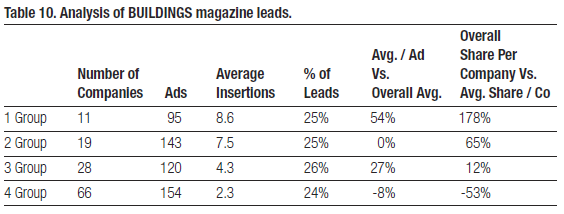
Consider Table 10. This Table shows an analysis of leads in BUILDINGS magazine for this report. There are four groups of advertisers, which have been sliced into quartiles based on total number of leads (Total Leads/4 = 4 groups, each with equal totals of leads). In other words, the total leads were evaluated, ranked them highest to lowest in terms of inquiry generation, and then sliced them into four even quarters so each quartile produced the same number of leads.
Immediately you see something interesting: 11 companies control 25% of the leads. These 11 (the elite) companies did only one thing different than the other groups: They ran more ads from a per company point of view. Their average insertion rate was 8.6. The reward for this? They not only control 25% of the leads coming from the magazine, their average number of leads compared to the other companies in the magazine was 178% HIGHER! Talk about a return on your investment!
This is not only remarkable; in this day and age of “skimming,” it is a testimony to the fact that people do read and respond through a reader service card. Because AIM had clients in that group of 11, the follow-up of the leads determined that each and every one of the responses had something to “offer” the client, whether it was in new specifications, samples requested or projects in the works.
The ads followed the Readership Chain, and they were noticed. Then people read and responded to these ads. A careful study of Table 10 will also reveal that “playing” with advertising isn’t worth it. If an advertiser can only afford running one or two ads, the company is better off doing something else with its money. Publishers will not appreciate hearing that, but the facts speak for themselves.
Summary
One of the questions AIM asked people is if they inquired on ads from other magazines besides BUILDINGS. Incredibly, 83% said that they do. But more important, AIM also asked what other magazines they receive. The people interviewed listed over 84 other magazines that they get (including naming BUILDINGS as the one they only get in some cases). Another qualifying question was added to this, which was: How do those magazines compare to BUILDINGS? The answers are both revealing and important. Regardless of which magazines respondents said they also receive, the strength of magazines (and BUILDINGS in particular) comes through. Please see Appendix 4 for insightful information.
Inquiry behavior has changed due to the Internet. However, the behavior of people who are seeking information has not: They seek information continually for the work they are performing, and it is up to the advertisers to harvest these leads and turn them into business.
This white paper offers not only the evidence, but ideas thanks to BUILDINGS magazine on how to do just that.
Footnote
Part of the intent of this research is to help advertisers better communicate, reach and target this important audience within BUILDINGS magazine. One of our questions dealt with just that: What’s the best way to reach a person like you? This was asked as the “final” question, after all the other rich data we gathered. What do you think was their response?
Best way to reach these people
| 53% | |
| Phone | 44% |
| 8% | |
| Other | 22% |
Remember “reach” means contact – the way they wanted to be contacted. It is extraordinary when you think about it, isn’t it? “Other” includes “articles, fax, internet, links to a live person, magazines, newsletters, and product literature.” But the fact of the matter is, they ARE reachable, not through one method, but ALL methods! Thus, when a lead is generated from BUILDINGS, the BEST way to reach these people is with a phone call or an e-mail – which we have proven year after year for our clients.
Equally important, another question of vital interest to both publishers and advertisers along these lines is if electronics would replace print. 46% said “Yes” to it, and 17% “Did not know.” However, 37% said that electronics would NOT replace print. In this day and age of social media explosions, it’s somewhat reassuring, isn’t it, that almost half of this important audience relies on print!
Thank you for the opportunity to present this research, and a special thanks to BUILDINGS magazine for their data.
Appendix 1.
Responses from interviews whether or not the product inquired about was purchased.
“Yes” Responses
- Absolutely. I have researched and recommended sub systems as a result of some of the products I have seen/read about in the magazine.
- Can’t really say it is a It usually takes a while until we would purchase a product. But knowing about it is important.
- Has purchased from people who advertise, but not always because of the ad in the magazine, sometimes because he already buys from them.
- He believes he has purchased.
- I am sure over the years I have purchased (He couldn’t remember the specific product he inquired on because usually more than one.)
- I believe, I purchased flooring from an ad in Buildings.
- I saw a Sloan Valve product and A rep. came out to see me.
- Insulation and an Infrared Scanner for Read article, received requested information, went to seminar and purchased the product.
- It’s a simple process: I sign the checks and I do most of the ordering I do have individuals that sit down and talk with me when I do a certain thing and get their I’m the chairman of the board and the treasurer.
- I’ve added suppliers to my list after reading about them.
- Lights and software–I know I have inquired about more products.
- On a couple of occasions because that is the only place he can get them.
- Quite a few.
- Recommends.
- Signed up for Blue Book & called on other products; wanted to go see a part that he hasn’t purchased.
- Sure, I have but can’t As the maintenance supervisor/building operations – I requisition what we need and the school board treasurer approves depending on finances.
- We have a corporate structure; when we need products that department makes the necessary purchases.
- We usually will spec it.
- Worked well.
- Yah, but I’m drawing a I’m sure I have inquired and said, let’s give that product a try. I work with an agent from the procurement division. I am a decision-maker collectively with procurement.
- Yes, in different Find a retailer; go to the equipment, and fine the factory rep. Pumps and such.
“No” Responses
- But, there is stuff in there they buy anyway; already have a relationship with the with the manufacturer.
- Don’t buy for our company. We are consultants and assess ways to solve our clients’ problems. Our clients are hospitals, hotels, and we are getting into Data Centers.
- Don’t purchase – I I did a descriptive spec on aluminum panels I saw advertised. This is the government I can’t use product names.
- Don’t recall specifically from builder, but I have purchased products from ads. Products are purchased by maintenance, through specifications or I write an acquisition.
- Four estimators work at our company. We individually submit purchase orders.
- He is an architect and doesn’t really purchase the materials, just needs the information.
- He uses some of the products, but doesn’t really think he could say he purchased it directly because of the of the ad.
- I do purchase things. I have to go through channels.
- I don’t recall, but I’m sure we have over the years. We are a small property management firm – I ask my property manager to look over what we are interested in purchasing at the website.
- I make the approval.
- I have several clients from the past who still call me for projects. My full time job is teaching.
- I know we use various products that are in there, but whether a specific ad caused me to do that, I don’t know.
- I’m not the purchasing agent, but I’m the director of a physical plant, so I have a say.
- I’m trying to I think the articles have influenced me in making me thing about life cycle and what I need related to roofing. I’m a one-man show, the owner and decision-maker. I try to make decisions that will save me money and my tenants.
- No, but I have done product research on thing I have seen advertised. At my company I recommend to the CEO/Owner products for capital improvements. At certain levels, I buy what is needed.
- One of the other facilities people could have inquired or this information was sent to them to handle. I don’t recall inquiring on a specific ad.
- We are a government agency so you can figure out the rest.
- We are a small company; if you see something and it’s not expensive you take it to your the boss and show him. We buy it out of petty cash or he puts it on his credit card. The Fluke product was expensive, so we didn’t buy it.
- We have a vendor list that we cannot deviate from.
- We specify products for Broward County Schools. We don’t purchase. Information is important.
- We’re a consulting firm; we don’t purchase.
Appendix 2.
Verbatim comments from people interviewed about if it is important to advertise in buildings magazine.
- Advertising in major trade publications give manufacturers and service providers more credibility. Also give their products national exposures. Small companies can’t do that.
- Basically introduction of new products; unless he sees it in the magazine, he will probably not find it by searching the internet since he wouldn’t know what he was looking for.
- Because that is how you learn about products. It also gives a company a certain level of credibility if you are advertising in a magazine like Buildings. It is a good way for me to stay educated on what is out there and exposed to new products.
- Buildings is not just a general purpose magazine. It is a magazine read by people who use products.
- Catches my eye, read. Just this morning, I requested information on flow meter to balance the chilled water system.
- Even though he doesn’t get subscription he always goes to our site to look for the company information.
- He works with a lot of condominium boards – always looking for solutions. He is often asked for product referrals. He also reads and responds to ads listed in back of the magazine.
- I find the most useful advertising is for awareness to me on new products.
- I look at ads and get ideas from them. I like ads that talk about the product and methods for solving problems.
- I scan the magazine for advertised products.
- I think because it gives you names and products along with pictures of the product.
- If the magazine puts out the ads for new products it is helpful to the readers.
- If you got a 2 by 2 or 4 by 4 picture which describes your product and what it can do then I think that is great. It is too hard to search the internet. I like to see the pictures with just bullets of what it does.
- Important for the reader to know that there are new products.
- Important, but not critical; I would say 75% important – we resell products manufactured by Schneider Electric. It is good for to advertise in the magazine. We are consultants regarding monitoring of electrical energy cost, and sell reduction methods.
- In the commercial industry, how else would you get the information out? It’s good for contractors and building owners to see what is new.
- It is essential to keep up with new technology.
- It keeps us abreast of the new products out there.
- Just a way to get the word out on their products.
- Lets us know what the latest and greatest is.
- Need to know about new products.
- New technology & new products are constantly coming out.
- Not on a grand scale, but people who receive the magazine need to know & appreciate the effort that Buildings & manufacturers go to get the magazine published.
- Often times that is how we learn about new new things.
- On a scale of 1 to 10, I would say a It helps me learn about new products. It is hard to learn about something new if you don’t know it exists. Searching on the Internet can take time and you still wouldn’t know it is new.
- Part of the reason I read it is to see new products or adaptive use in buildings – new ways to use products that have been around for awhile.
- People get it and see the ads.
- Pick up on things that are new and you might not see in your daily work.
- Pretty Huge! Articles have many sources that are cutting edge. Then you can look through that issue for product information at the same time. Combination is pertinent/interesting.
- Real Important – how else do you become aware?
- Really important because other people see your information and respond.
- Seeing an ad is based on the reader’s interest – I saw an ad for Fluke on an electric/heat measuring device. I thought this would be good to take to a tenant’s apartment when they complain about the heat.
- Some people can’t get things online; no time to read Likes to read at lunch, not looking at the computer. Ads are perfect because they pertain to what he is doing.
- Some stuff he would not have found unless he saw them in the magazine. Finds local dealers of products.
- That’s all that it is, isn’t it?
- That’s how we get to see what’s out there. Its ever-changing and this is how you get new information.
- That’s how you find out about new things, unless you see then in architect’s specs. If you see something you can incorporate it with building architect. Have to stay in front with sustainability.
- That’s why I look through the magazine.
- They found a lot of stuff.
- They have to advertise to tell who they are or nobody would know them.
- This is a very important targeted audience – the specifier and the end-user.
- When I am looking for a specific product I usually remember where I have seen it and go back to that magazine.
- Yes, things are changing so fast they really keep up with changes.
Appendix 3.
Whether or not people were satisfied with the way advertisers followed up to inquiries in buildings magazine.
- Absolutely, I check off the response card and within one to two weeks I have the information on. I inquired If I want it quicker, I will get information off the website. Because of multiple projects, I need hard copies to take to meetings.
- And sometimes they were able to send sample products so he could do a show and tell w/end user to find out if that is what they are looking for.
- Better than years ago because of the Internet.
- Companies send or e-mail brochure and I go from there. Often a manufacturer’s rep will call.
- Don’t have any complaints. I prefer to receive mailings for things I have requested.
- First and foremost happy about the way they receive leads from the magazine – complete and, then the follow-up! Candidly – Both are equally important.
- Fluke sent a brochure, in another case, it was a boiler manufacturer and they sent several brochures. (Sometimes, you don’t get anything.)
- For the most part I get what I need.
- For the most part, yes.
- For the most part, yes. With one or two, I was a little disappointed.I didn’t like the first rep who contacted me once. But then 6 months later, there was turnaround and the next person was more helpful.
- Generally, mailed information.
- Get tons of literature & it is always sent on a timely basis.
- Got literature from them, e-mails.
- He thinks they are very responsive & quick; calls, etc.
- I got the literature and usually a follow-up call and they were sent pretty quickly after I requested something.
- I saw a Sloan Valve product and A rep called.
- I usually get the literature. Sometimes a rep calls, but usually I just get information.
- In general, I think companies are pretty good with follow-up. Usually, get a response first by e-mail and then a phone. If reps are present in the Twin Cities – they will call on me if I have the time to see them.
- Most times (80%) I just request literature. Other times I will call or ask for a rep. Sometimes when I get the literature, I will call the rep to get additional information. It is a two or three step process.
- Normally, with a phone call and a combo of printed I use the Internet, but I like to have it in print. I don’t mind it being sent in an e-mail, but I’m on back end of my career. I’m kind of a dinosaur. They’re always good about get.
- Not sure. Sometimes I get e-mails. Not sure really if I received anything or not.
- Receive information for research.
- Received phone call or e-mail – fairly quick response. Sometimes, reps call. I get lots of e-mails. If I am offered a White Paper – telling me the product is the greatest thing since sliced bread – I know it is a sales lead.
- Receives literature 50% of the time – he may circle 5 numbers – doesn’t always remember everything requested – information does not all come at one time. Difficult to remember everything requested. Rare that reps call.
- Respond very quickly, send information; he was talking to a friend who has a cleaning company & he shared some information with him & the company was very helpful.
- Sent literature very quickly & follow-up call.
- There was an article 4-5 years ago regarding Styrofoam bumper guards that went over corners; contractor left sharp edges; he remembered where he saw something about these bumpers & he ordered them; called California; ordered the product.
- They really didn’t have to do much since I went online for the information.
- They send out the brochures.
- Typically a rep contacts me.
- Usually get good results. Honest.
- Usually get in a timely fashion.
- Yes, a rep gave him a call.
- Yes, I think they respond pretty good, within a few days I will get a call from a rep or a manufacturer.
- Yes, I’ve received mailings and phone calls. It’s rare that we don’t hear from someone.
- Yes, most advertisers usually do follow-up. I had a manufacturer of solar panels send me a mug with their contact information. I use the mug daily. I will call them in 2012 before the start of a new project.
- Yes, no bad experiences. I have received information and phone calls. If I call a company – I receive returned phone calls, even from big companies, say the size of 3M.
Appendix 4.
How publications people receive compare to BUILDINGS magazine.
- All are different and there is not much to compare.
- All magazines are similar/comparable – I don’t want to hurt anyone’s feelings – as for information – all presented in the same manner.
- All the same.
- American School & University has a lot of pictures of other campuses not a lot of deep information. 2. I like to look at how the rest of the world is handling issues. I look for information.
- American School & University is targeted to schools, but BUILDINGS magazine is very good – a lot does relate to buildings.
- Building Operations Management is more to my needs – I am more interested in operations side of running the building.
- BUILDINGS is comparable to the other magazines, it does offer a little more education than the others.
- BUILDINGS is laid out better and has good graphics. I am having trouble with the bar codes to read on my Smart Phone, but I don’t really want to or need to get information that way.
- BUILDINGS is one of the better magazines, along with Building Design and Construction and Architectural Record. BUILDINGS is a top magazine for its content and articles.
- BUILDINGS is straight to the point. Has a wider range of articles. It is helpful to maintenance people. Easy to read. Printing is better than Arch Record. There is a bigger FONT in BUILDINGS. Photographs as good as ARCHITECT.
- BUILDINGS is the best – all the publications I read have something to offer – topic specific.
- BUILDINGS is the only magazine that he receives in the building category.
- BUILDINGS or BOM pretty same. Intelligent Energy is specific to energy.
- Completely different and actually not much comparison.
- Condo Life has more specific articles for owners and tenants; like how to run a Board Meeting.
- Difference in products; types of business; Security Dealer has gone downhill in the last couple of years; mostly articles, not products.
- Each one is different, don’t compare to BUILDINGS. Owner’s Perspective is planning for a building geared for long term ownership. All the magazines do an adequate job for their title. All have different articles.
- Engineered systems is more technical; sometimes too technical.
- Facility Management – BUILDINGS; FM goes into depth w/sustainability becoming a big topic these days; just got his accreditation from International Facility to become a sustainability management professional; covers more than just Green.
- Focus on BUILDINGS: Likes the size of the magazine small & compact. Likes the print/page layouts – not super glossy. Easy to read. You can see it is a high quality magazine – economically and environmentally.
- I don’t get any other magazines but BUILDINGS for my job.
- I like BUILDINGS because it’s concise, specific to what I’m looking for and it’s not a large magazine. That’s maybe not what you want to hear when you’re trying to sell advertising. The one reason I like it is I can look at the index.
- I think it is a bit better than some of the others. It address some of the larger issues in the industry. Sometimes though I like the product books (like Architectural Product) because I am just looking for products.
- It is about the same except it concentrates on existing buildings where some of my other magazines are new construction.
- Maintenance solutions has to do all w/maintenance things for schools; not just schools but commercial business; lighting, wiring, sheet metal, painting, tools. Information on retrofits on gymnasiums; he gets a lot of information to take to the meetings.
- More just type of product; he is in hospitality and those products are covered more in other magazines.
- Not as good; not same info. With BUILDINGS on the Internet it is easier to read. I don’t have time to page through a magazine. I would just throw it away frankly.
- The company does inspect property for commercial buyers – need to be up to date on roofing, parking, HVAC, etc. However, most of the business is homes and multifamily residential.
- The first publications I mentioned are more design orientated, so it’s hard to compare construction vs. design. They are different in orientation, so you really can’t compare.
- The publications I like are all very similar. There’s redundancy in the ads. The same manufacturers advertise in the same publications. BUILDINGS does as good a job as anyone.
- They are all different with different applications. I don’t like one over the other.
- They are all different. There is no comparison. It’s like comparing apples to oranges. There is different info.
- They carry more of the products I use in the multi-family industry and remodeling industry.
- They tend to have different, narrower, focus. Not as much product information.
- They’re more specialized, different audiences.
- Very different.
- Very pleased with BUILDINGS; likes it much better than any others he has been.
- Very similar, I don’t think one is more comprehensive than the other.